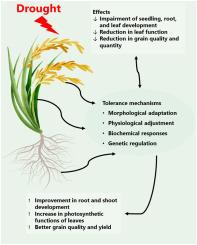The responses and adaptations of rice (Oryza sativa L.) to drought stress: A review
引用次数: 0
Abstract
The rise in global temperature due to human activities poses a threat to the survival and productivity of plants. As sessile organisms, plants are frequently exposed to abiotic stressors, among which drought is the most critical factor limiting rice (Oryza sativa L.) yield worldwide. Understanding the mechanisms underlying drought adaptation in rice is essential for breeding drought-resilient genotypes. Advancements in molecular biology, genomics, and high-throughput phenotyping have uncovered complex networks of genetic, biochemical, and physiological responses that enable rice to withstand drought stress. This study examines the adverse effects of drought on rice and the mechanisms employed by rice to adapt to drought, utilizing an integrated molecular, biochemical, and physiological approach. It highlights the multifaceted nature of drought tolerance and its implications for developing resilient cultivars. Key mechanisms identified include osmotic adjustment, morphological changes, the expression of drought-responsive genes, the secretion of stress-related phytohormones, and the activation of antioxidant enzymes, all of which contribute to maintaining cellular homeostasis. Transcriptome and proteome analyses have expanded the catalogue of stress-responsive genes and proteins, particularly those involved in abscisic acid signalling, aquaporins, and late embryogenesis abundant proteins. The regulatory roles of transcription factors such as DREB, NAC, and MYB in modulating these stress-response pathways are emphasized. Furthermore, genome-wide association studies and quantitative trait locus (QTL) mapping have identified genomic regions associated with drought tolerance, providing valuable targets for marker-assisted selection in breeding programs. The integration of these findings offers a roadmap for improving rice varieties with enhanced drought tolerance. Future research should focus on validating candidate genes, proteins, and QTLs across diverse genetic backgrounds to ensure stable productivity under water-limited conditions.

水稻对干旱胁迫的响应与适应研究进展
人类活动导致的全球气温上升对植物的生存和生产力构成了威胁。植物作为一种无根生物,经常受到非生物胁迫,其中干旱是世界范围内限制水稻产量的最关键因素。了解水稻干旱适应机制对于培育抗旱基因型至关重要。分子生物学、基因组学和高通量表型学的进步揭示了水稻抵御干旱胁迫的遗传、生化和生理反应的复杂网络。本研究利用分子、生化和生理的综合方法,探讨了干旱对水稻的不利影响以及水稻适应干旱的机制。它突出了抗旱性的多面性及其对开发抗旱品种的影响。主要机制包括渗透调节、形态变化、干旱响应基因的表达、胁迫相关植物激素的分泌和抗氧化酶的激活,这些都有助于维持细胞内稳态。转录组和蛋白质组分析已经扩展了应激反应基因和蛋白质的目录,特别是那些涉及脱落酸信号,水通道蛋白和胚胎发生晚期丰富的蛋白质。强调了DREB、NAC和MYB等转录因子在调节这些应激反应途径中的调节作用。此外,全基因组关联研究和数量性状位点(QTL)定位已经确定了与耐旱性相关的基因组区域,为育种计划中的标记辅助选择提供了有价值的目标。这些发现的整合为提高水稻品种的耐旱性提供了路线图。未来的研究应侧重于验证不同遗传背景下的候选基因、蛋白质和qtl,以确保在水分限制条件下稳定的生产力。
本文章由计算机程序翻译,如有差异,请以英文原文为准。
求助全文
约1分钟内获得全文
求助全文

 求助内容:
求助内容: 应助结果提醒方式:
应助结果提醒方式:


